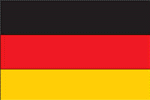Germany
| Law Summary | Ordinance on the Avoidance of Packaging Waste2 makes manufacturers responsible for taking back the packaging of their products and sets targets for refilling and recycling rates |
|---|---|
| Date Implemented | January 1, 2003 (Packaging ordinance was passed July 1, 1993, but container deposits were not put into effect until 2003) |
| Containers Covered | Glass, aluminum, plastic drink containers between .1 and 3 litres |
| Beverages Covered | Beer, soft drinks including lemonade, mixed spirits. Excludes juice, drinks with over 50% milk content. |
| Refundable Deposits |
|
| Reclamation System | Return to retail |
| Program Success | Recovery/Redemption Rate as of 2011: 96% Aluminum Can In 1998, Refillables comprised 75% of the beverage market and the following percents of market share in the following categories:
Recycling Rates for packaging materials (2005 data)4
|
Details
Should recycling targets (glass: 90%; aluminum: 90%; plastic: 80%) not be met by January 1, 1995, deposits were to be required for all non-refillable liquid containers, including beverages, liquid soaps and paint.
A provision in the Packaging Ordinance requires industry to maintain a minimum level of refillable containers, which for beer, soft drinks, fruit juice, mineral water and wine is 72% (milk 17%). If the levels are not maintained, the government was to set mandatory deposits. The market share of refillables rose to 75% after passage of the law, but fell below the required 72% between 1997 and 2000.6
Drink container deposits were set to be implemented on January 1, 2003 but the deadline was extended to Oct 1, 2003.1Originally, the deposit was 25 Euro ¢ for containers under 1.5L and 50¢ for larger containers, but that distinction was dropped after an amendment in 2005, and now the deposit for all containers is 25¢3. All deposit amounts are in eurocents.
Retailers were originally only required to take back the brands that they sell, but the law was amended in 2004 to require them to take back all containers that are made of the same material as containers they sell.7
The deposit also applies to detergents, cleaners, and emulsion paints (subject to some different requirements and deposit amounts). While the Packaging Ordinance also requires distributors and manufacturers to accept and recycle or reuse returned packaging for other products, there is no deposit charged on these other materials. Rather, the manufacturers fund the system by paying fees to product stewardship organizations.5
Refillable containers, which make up a significant portion of the beverage market in Germany, are exempt from the Packaging Ordinance, but carry voluntary deposits of 8 eurocents for beer bottles and 15 eurocents for noncarbonated beverage bottles.
Federal Environmental Agency says that re-usable bottles account for 45.7 per cent of all drinks sold in Germany. The advantage of these bottles is they are refilled 40 to 50 times, and are therefore more environmentally friendly than single-use bottles.9
Footnotes
1. Source: Report by the Government of the Federal Republic of Germany on the implementation of the compulsory deposit for one-way drinks packaging by October 2003. October 2003. http://www.bmu.de/files/pdfs/allgemein/application/pdf/pfandpflicht_berichtaneu_uk.pdf
2. Ordinance on the Avoidance and Recovery of Packaging Wastes (Packaging Ordinance - Verpackungsverordnung - VerpackV1) of 21 August 1998 (Federal Law Gazette I p. 2379) as last amended by Article 1 Third Amending Ordinance2 of 24 May 2005 (Federal Law Gazette I p. 1407 of 27 May 2005) Unofficial text. May 2005. http://www.bmu.de/files/english/waste_management/downloads/application/pdf/verpackv_3aenderung_en.pdf
3. Source: Federal Ministry for the Environment, Nature Conservation, and Nuclear Safety. "New provisions for the deposit on drink cans in Germany." May 2006. http://www.bmu.de/english/waste_management/general_information/doc/35155.php
4. Source: Federal Ministry for the Environment, Nature Conservation, and Nuclear Safety. "Sales Packaging: Consumption, recycling, quotas 1991 to 2005," (citing Gesellschaft für Verpackungsmarktforschung mbH (GVM), Recyclingbilanz, November 2007). March 2008. http://www.bmu.de/files/pdfs/allgemein/application/pdf/sales_packaging_consumption_1991_2005.pdf
5. Source: R3 Consulting Group and Clarissa Morawski. "Germany Packaging Ordinance (Duales System)." Evaluating End-of-Life Beverage Container Management Systems for California. Section 9-1. May 15, 2009.
6. Source: Report by the Government of the Federal Republic of Germany on the implementation of the compulsory deposit for one-way drinks packaging by October 2003. October 2003. http://www.bmu.de/files/pdfs/allgemein/application/pdf/pfandpflicht_berichtaneu_uk.pdf
7. Source: R3 Consulting Group and Clarissa Morawski. "Germany: Deposit-Return" Section 10-1. Evaluating End-of-Life Beverage Container Management Systems for California. 2009.
8. Source: R3 Consulting Group and Clarissa Morawski. "Germany: Deposit-Return" Section 10-8. Evaluating End-of-Life Beverage Container Management Systems for California. 2009.
9. Source: New Age Publications http://www.thenewage.co.za/153091-1020-53-Germany_threatens_CocaCola_with_tax_to_deter_disposable_bottle_use 2015.

